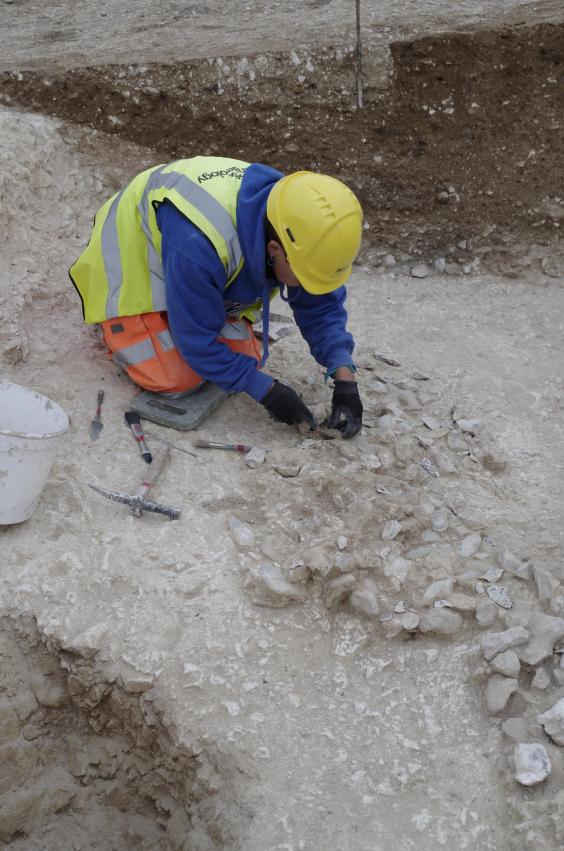A vast prehistoric ceremonial complex has been uncovered in a city around 2.4 km (1.5 miles) from Britain's Stonehenge.
The site is further evidence that, hundreds of years before Stonehenge was built, the entire region was more ritualistically active than archaeologists had previously thought. And it could shed light on why the mysterious circular stone monument was built in the first place.
There have been many hypotheses about the purpose for Stonehenge, including the idea that it was used as an astronomical calendar, or some kind of religious site.
But until now, there hasn't been a huge amount of context. The closest major nearby monument that was built before the site - during the early Neolithic period - is known as Robin Hood's Ball, and it's around 4 km (2.5 miles) northwest of Stonehenge.
Despite being listed as an official monument in 1965, Robin Hood's Ball has yet to be fully excavated, and its purpose still isn't properly understood.
So this new monument offers an unprecedented insight into what the Stonehenge area was like from a cultural point of view before the famous monument was built.
"The newly found site is one of the most exciting discoveries in the Stonehenge landscape that archaeologists have ever made," a prehistorian with Wessex Archaeology, who is helping to excavate the site, told David Keys from The Independent.
"It transforms our understanding of the intensity of early Neolithic activity in the area."
The new complex was built around 5,650 years ago – more than 1,000 years before Stonehenge was completed – and is what's known as a causewayed enclosure, which consists of around 950 metres (3,116 feet) of segmented ditches arranged in two concentric circles.
Causewayed enclosures get their name from the fact that their circular ditches are 'crossed' by multiple causeways, and are a common but mysterious type of prehistoric monument.
There are around 70 known in England - Robin Hood's Ball is also a causewayed enclosure - but although researchers have found some evidence that they were used for a mixture of ceremonial, mortuary, and political purposes, there's still a lot we don't know.
The latest structure was discovered below Larkhill, a town in Wiltshire that's home to numerous military buildings, and was detected by the UK Ministry of Defence when they were preparing to build British Army houses on the land.
The Ministry of Defence has now funded the area to be fully excavated to find out more about what's going on beneath the site.
So far, archaeologists have excavated around 100 metres – roughly 17 percent – of the outer ditch, so it's still early days.
But they've found evidence for regular ritualistic use of the structure, including fragments of deliberately smashed bowls, large amounts of cattle bones, and human remains.
The team says this indicates that the complex was home to ceremonies, where people feasted on large quantities of beef, and later purposefully smashed their ceramic bowls.
Some of the ditches in the structure also appear to have been used for the burial of human remains, which suggests that this was a sacred space. The team has so far found four human cranial fragments in one of the ditches that they think belonged to a single individual.
The researchers will now begin testing the remains of the ceramic bowls to try to determine what they were used to carry.
Interestingly, the archaeologists also found a pottery urn in this section of the ditch that's around 1,900 years younger than the rest of the remains, suggesting that the complex was used for thousands of years after it was built - long after Stonehenge had been constructed.
None of these suggestions have been peer-reviewed as yet, and the work is still ongoing, so we need to wait on further excavation and analysis before we get too excited.
But the fact that the monument has been discovered at all suggests that there's likely other important monuments in the area just waiting to be found - in fact, causewayed enclosures are known to occur in pairs or clusters of three or four.
Earlier this year, researchers found the remains of a 4,500-year-old giant wooden circle that was five times bigger than Stonehenge and located just 3.2 km (2 miles) northeast of the site.
"These discoveries are changing the way we think about prehistoric Wiltshire and about the Stonehenge landscape in particular," archaeologist Martin Brown from consultancy company WYG, which is leading the Larkhill housing development, told The Independent.
"The Neolithic people whose monuments we are exploring shaped the world we inhabit. They were the first farmers and the first people who settled down in this landscape, setting us on the path to the modern world."


Comments
Post a Comment